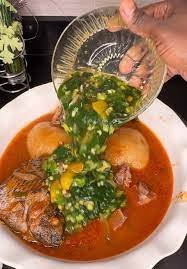Nutrition
‘Pipinaso’

‘Pipinaso’ is a special delicacy prepared during the Ohum festival of the people of Akwapim (Larteh) in the Eastern Region.
It is mostly served with light soup and dried fish. The traditional meal is served with okro soup.
‘Pipinaso’, is also used to perform rituals at funeral grounds and also served as food to infertile to boost their chances of making babies.
Ingredients
-2 cups of roasted corn flour
-Water
Preparation
-Put water on the fire to boil
-Add roasted corn flour to water and stir gently
– Continue stirring until it mix uniformly
-Add some of the hot water to soften it if it’s hard
– Allow it to boil for sometime and serve with light soup.
By Linda Abrefi Wadie
Nutrition
Why RUTF must be added to the NHIS; A call for national action

Despite RUTF’s proven ability to save lives, access to it in Ghana remains inconsistent. Many caregivers face long travel distances to treatment centres, only to be told that supplies have run out. Others rely on community health workers who do their best but struggle with stock shortages. The core challenge is simple: RUTF in Ghana depends heavily on donors, and when global priorities shift or funding gaps emerge, children suffer.
RUTF’s which stands for Ready-to-Use Therapeutic Food is a high-energy, micronutrient-rich food paste designed to treat severe acute malnutrition in children. This raises an important question: why is a life-saving product, essential to child survival, not covered under the National Health Insurance Scheme (NHIS)?
Including RUTF in NHIS would mark a monumental shift in how Ghana approaches child health. Firstly, it would ensure that access to RUTF becomes a national obligation, not an act of charity. Severe acute malnutrition is a medical condition, just like malaria, pneumonia, or diabetes, and must be treated as such. With RUTF included in the NHIS medicines list, families would be guaranteed treatment without depending on unpredictable donor supplies.
Secondly, integrating RUTF into NHIS is cost-effective. Untreated malnutrition leads to complications such as severe infections, developmental delays, and prolonged hospital admissions, all of which are far more expensive for the health system than early intervention. Investing in RUTF through NHIS would reduce long-term healthcare costs while strengthening Ghana’s commitment to the Sustainable Development Goals, particularly SDG 2 and SDG 3.
Thirdly, including RUTF in the scheme would help eliminate inequities. Currently, access varies by region. Children in remote or hard-to-reach communities often suffer the most. When RUTF is made universally available, every child is guaranteed treatment when they need it.
Additionally, NHIS coverage of RUTF would help streamline procurement systems, improve supply chain consistency and strengthen accountability mechanisms, a gap that currently undermines national nutrition efforts.
At its core, this is an issue of fairness, governance, and national responsibility. If Ghana truly prioritises child survival, then RUTF must be placed where it belongs, that is, within the NHIS as an essential, guaranteed treatment.
Feature article by Women, Media and Change under its Nourish Ghana: Advocating for Increased Leadership to Combat Malnutrition project
Join our WhatsApp Channel now!
https://whatsapp.com/channel/0029VbBElzjInlqHhl1aTU27
Nutrition
Custard Ice Cream Recipe

Ingredients
• 4 tablespoonful of milk powder
• 2 cups of fresh milk
• 1 cup of condensed milk (sweetened)
• 2 tablespoonful of vanilla custard powder
• 1 teaspoonful of vanilla essence
Optional: Sugar (only if you want extra sweetness, since condensed milk is already sweet)
Preparation
- Mix the custard base in a small bowl
- Dissolve the custard powder in ½ cup of cold milk to make a smooth paste
- Cook the custard and heat the remaining milk in a saucepan
- Stir in the Cowbell milk powder until fully dissolved
- Add the custard paste and cook on low heat, stirring continuously until it thickens slightly
- Remove from heat and stir in the condensed milk
- Add vanilla essence for flavour
- Taste and adjust sweetness if needed
- Let the custard mixture cool to room temperature
- Cover and refrigerate for at least 3–4 hours (overnight is best)
- Scoop into bowls or cones and enjoy your homemade custard ice cream







